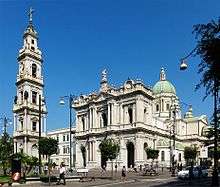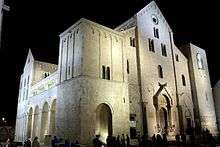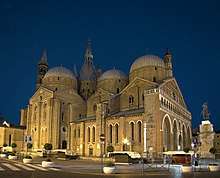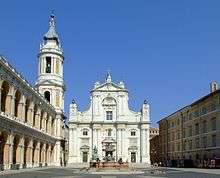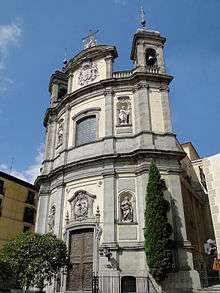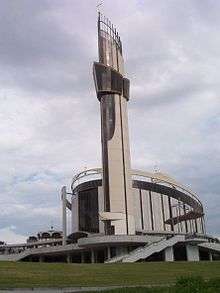Basilicas in the Catholic Church
In the Catholic Church, a basilica is a large and important church building designated as a basilica by the Pope and thereby distinguished for ceremonial purposes from other churches. It does not need to be a basilica in the more general architectural sense, a large public building with multiple functions, typically built alongside the town's forum. Basilicas are either major basilicas — of which there are four, all in the diocese of Rome — or minor basilicas, of which there were 1,810 worldwide as of 2019.[1]
Numerous basilicas are notable shrines, often even receiving significant pilgrimages, especially among the many that were built above a confessio or the burial place of a martyr – although this term now usually designates a space before the high altar that is sunk lower than the main floor level (as in the case in St Peter's and St John Lateran in Rome) and that offer more immediate access to the burial places below. Some Catholic basilicas are Catholic pilgrimage sites, receiving tens of millions of visitors per year.[2][3] In December 2009 the Basilica of Our Lady of Guadalupe set a new record with 6.1 million pilgrims during Friday and Saturday for the anniversary of Our Lady of Guadalupe.[4]
Churches designated as papal basilicas, in particular, possess a papal throne and a papal high altar, at which no one may celebrate Mass without the pope's permission.[5]
Ranking of churches

The papal or major basilicas outrank in precedence all other churches. Other rankings put the cathedral (or co-cathedral) of a bishop ahead of all other churches in the same diocese, even if they have the title of minor basilica. If the cathedral is that of a suffragan diocese, it yields precedence to the cathedral of the metropolitan see. The cathedral of a primate is considered to rank higher than that of other metropolitan(s) in his circonscription (usually a present or historical state). Other classifications of churches include collegiate churches, which may or may not also be minor basilicas. Not until the early eighteenth century was a distinction made between major basilicas and minor basilicas. The earliest document that records the use of the term “major basilica” dates from 1727.[6]
Major or papal basilicas
To this class belong only the four great papal churches of Rome, which among other distinctions have a special "holy door" and to which a visit is always prescribed as one of the conditions for gaining the Roman Jubilee. Only the major basilicas may prefix their titles with the adjective sacrosancta (most holy).[7]Upon relinquishing in 2006 the title of Patriarch of the West, Pope Benedict XVI renamed these basilicas from "Patriarchal Basilicas" to "Papal Basilicas".
- St. John Lateran, also called the Lateran Basilica. Since it is the cathedral of the pope, in the tradition of the Catholic Church, it has claims as the Mother Church of the world. For this reason, St John Lateran is the only church that is also known as an “archbasilica”.
- St. Peter's Basilica, also called the Vatican Basilica, is a major pilgrimage site, built over the burial place of Saint Peter.
- St. Paul Outside the Walls, also known as the Ostian Basilica because it is situated on the road that led to Ostia, is built over the burial place of Paul the Apostle.
- St. Mary Major, also called the Liberian Basilica because the original building (not the present one) was attributed to Pope Liberius, is the largest church in Rome dedicated to the Blessed Virgin Mary.
The four papal or major basilicas were formerly known as "patriarchal basilicas". Together with the minor basilica of St Lawrence Outside-the-Walls, they were associated with the five ancient patriarchal sees of Christendom (see Pentarchy). The Basilica of St John Lateran was associated with the pope, the Patriarch of the West; St Peter's with the Patriarch of Constantinople; St Paul's with to the Patriarch of Alexandria; and the Basilica of St Mary Major to the Patriarch of Antioch. At the Council of Chalcedon (AD 451), Jerusalem was raised to a patriarchate and the Basilica of St. Lawrence Outside-the-Walls was assigned to the Patriarch of Jerusalem. Nominally, the respective patriarchs could avail of accommodation attached to the basilicas should they have business in Rome.[8] These assignments, however, are now purely historical. In some cases, more than one patriarch holds the title for the same patriarchate. For example, each of the Catholic patriarchs of the Melkite, Maronite and Syrian rites holds the title of "Patriarch of Antioch".
Gallery of Major Basilicas
 Archbasilica of St John Lateran
Archbasilica of St John Lateran
41°53′9.26″N 12°30′22.16″E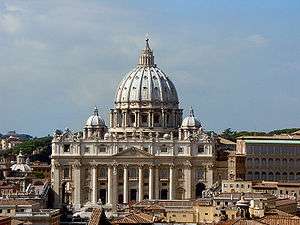 St. Peter's Basilica
St. Peter's Basilica
41°54′8″N 12°27′12″E- Basilica of St Paul Outside-the-Walls
41°51′31″N 12°28′38″E _frontview.jpg) Basilica of St Mary Major
Basilica of St Mary Major
41°53′51″N 12°29′55″E
Minor basilicas
The privileges attached to the status of minor basilica, which is conferred by papal brief, include a certain precedence before other churches, the right of the conopaeum (a baldachin resembling an umbrella; also called umbraculum, ombrellino, papilio, sinicchio, etc.) and the bell (tintinnabulum), which are carried side by side in procession at the head of the clergy on state occasions, and the cappa magna which is worn by the canons or secular members of the collegiate chapter when assisting at the Divine Office.[5] In the case of major basilicas these umbraculae are made of cloth of gold and red velvet, while those of minor basilicas are made of yellow and red silk—the colours traditionally associated with both the Papal See and the city of Rome.
Nonenclature difficulties
The terms "patriarchcal basilica", "papal minor basilica" and "pontifical minor basilica" are also in use.
Papal Minor Basilicas
There are three papal minor basilicas, one in Rome, Basilica of St Lawrence Outside-the-Walls, and two in Assisi [9][10] associated with Saint Francis of Assisi situated in or near his home town. Architecturally, the Papal Basilica of St Francis of Assisi is an aisleless nave with lateral chapels.
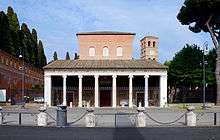
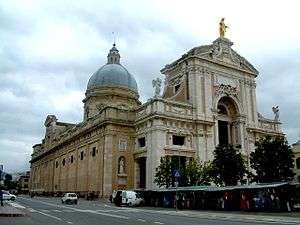 St Mary of the Angels
St Mary of the Angels
Assisi
Pontifical Minor Basilicas
There are five pontifical minor basilicas in the world (the word "pontifical" referring to the title "pontiff" of a bishop, and more particularly of the Bishop of Rome):
- Pontifical Basilica of Our Lady of the Rosary, Pompei
- Pontifical Basilica of St Nicholas, Bari
- Pontifical Basilica of St Anthony, Padua
- Pontifical Basilica of the Holy House, Loreto
- Pontifical Basilica of St Michael, Madrid
Patriarchal Minor Basilicas
The description patriarchal applies to two minor basilicas[10] associated with archbishops who have the title of patriarch: Patriarchal Cathedral Basilica of St Mark in Venice and the Patriarchal Basilica of Aquileia.

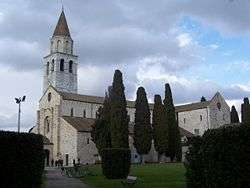 Patriarchal Basilica of Aquileia.
Patriarchal Basilica of Aquileia.
Not all patriarchal cathedrals are minor basilicas, notably: the Patriarchal Cathedral of St Mary Major in Lisbon, Portugal, the Patriarchal Cathedral of Santa Catarina, Old Goa, India.
Basilicas and pilgrimages
In recent times, the title of minor basilica has been attributed to important pilgrimage churches. In 1999 Bishop Francesco Giogia stated that the Basilica of Our Lady of Guadalupe in Mexico City (constructed in the 20th century) was the most visited Catholic shrine in the world, followed by San Giovanni Rotondo and Basilica of the National Shrine of Our Lady of Aparecida in Brazil.[12] Millions of pilgrims visit the shrines of Our Lady of Lourdes and Our Lady of Fatima. Pilgrimage basilicas continue to attract well over 30 million pilgrims per year.[12]
Every year, on 13 May and 13 October, the significant dates of the Fatima apparitions, pilgrims fill the country road that leads to the Sanctuary of Our Lady of Fátima with crowds that approach one million on each day.[13] In December 2009 the Basilica of Our Lady of Guadalupe set a new record with 6.1 million pilgrims during Friday and Saturday for the anniversary of Our Lady of Guadalupe.[14]
Ecclesiastical basilicas by region
As of 2019, there are 1,814 Roman Catholic churches that bear the title of basilica.[15]
| Region | Basilicas |
|---|---|
| West Europe | 1,091 |
| East Europe | 240 |
| North America | 142 |
| Central America | 24 |
| South America | 224 |
| South and East Asia | 52 |
| Central and Southwest Asia | 11 |
| Oceania | 7 |
| Western and Northern Africa | 14 |
| Eastern and Central Africa | 8 |
| Southern Africa | 1 |
| Total | 1,814 |
St. Mary's Cathedral in Ernakulam, India is the Episcopal See of the Syro-Malabar Catholic Church. The cathedral was elevated to the status of a Basilica by Pope Paul VI on 20 March 1974.[16][17] St. George Forane Church in Angamaly, also of the Syro-Malabar rite, was raised to the status of basilica on 24 June 2009 by Pope Benedict XVI.[18]
On 10 May 1997 Pope John Paul II visited the Basilica of Our Lady of Lebanon in Harissa, Lebanon. The basilica is under the Maronite Catholic Patriarchate.[19] The Basilica and National Shrine of Our Lady of Lebanon in North Jackson, Ohio, USA is under the jurisdiction of the Eparchy of Our Lady of Lebanon. The shrine was elevated to the status of a minor basilica by Pope Francis on 8 July 2014.[20]
Gallery of minor basilicas around the world
.jpg) Basilica of the Sacred Heart of Paris is a minor basilica, but not an architectural basilica
Basilica of the Sacred Heart of Paris is a minor basilica, but not an architectural basilica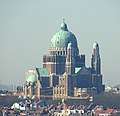 Koekelberg Basilica, Brussels
Koekelberg Basilica, Brussels Basilica of Saint Mary in Minneapolis, MN. The first basilica established in the United States.
Basilica of Saint Mary in Minneapolis, MN. The first basilica established in the United States.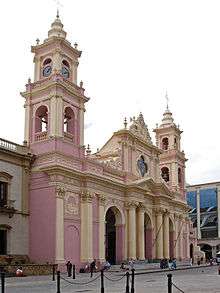
See also
References
- "Basilicas in the World". GCatholic.org. 2019. Retrieved 12 December 2019.
- Sacred Travels by Lester Meera 2011 ISBN 1-4405-2489-0 page 53
- "Eternal Word Television Network, Global Catholic Network". Ewtn.com. 13 June 1999. Retrieved 17 February 2012.
- "Zenith News December 14, 2009". Zenit.org. Archived from the original on 13 November 2011. Retrieved 17 February 2012.
- Gietmann, G. & Thurston, Herbert (1913). . In Herbermann, Charles (ed.). Catholic Encyclopedia. New York: Robert Appleton Company.
- Sergio Bianchi, Le Basiliche Minori (Rome: Marianum 1976), 2.
- Joachim Nabuco, Ius Pontificalium: Introductio in Cæremoniale Episcoporum (Paris: Desclée & Socii, 1956), 232.
- Dictionnaire de droit canonique, vol. 2, s.v. “basilique,” p. 242 (1937).
- "Book on Basilicas". www.gcatholic.org. Retrieved 17 July 2017.
- The title of minor basilicas was first attributed to the church of San Nicola di Tolentino in 1783. Older minor basilicas are referred to as "immemorial basilica".
- Sacred Travels by Lester Meera 2011 ISBN 1-4405-2489-0 page 53
- "Eternal Word Television Network, Global Catholic Network". Ewtn.com. 13 June 1999. Retrieved 17 February 2012.
- Trudy Ring, 1996, International Dictionary of Historic Places, ISBN 978-1-884964-02-2 page 245
- "Zenith News December 14, 2009". Zenit.org. Archived from the original on 13 November 2011. Retrieved 17 February 2012.
- "Basilicas in the World". GCatholic.org. 2019. Retrieved 12 December 2019.
- "St. Mary's Cathedral Basilica, Ernakulam", Syro-Malabar Church
- ""St. Mary's Cathedral Basilica, Ernakulam", Archediocese of Ernakulam–Angamaly
- " Edappally St George Forane Church", District Administration Ernakulam
- "Our Lady of Lebanon Basilica", Our Lady of Lebanon, Harissa
- "North Jackson Shrine being consecrated as Minor Basilica", WFMJ, 10 October 2014
External links
| Look up basilica in Wiktionary, the free dictionary. |
| Wikimedia Commons has media related to Major basilicas. |
| Wikimedia Commons has media related to Minor basilicas. |
| Wikimedia Commons has media related to Basilicas (architecture). |
Gietmann, G. and Thurston, Herbert (1913). . In Herbermann, Charles (ed.). Catholic Encyclopedia. New York: Robert Appleton Company.CS1 maint: multiple names: authors list (link)
- List of All Major, Patriarchal and Minor Basilicas & statistics by Giga-Catholic Information
